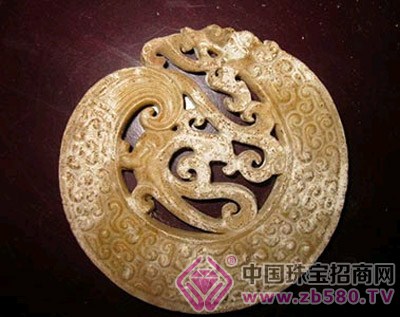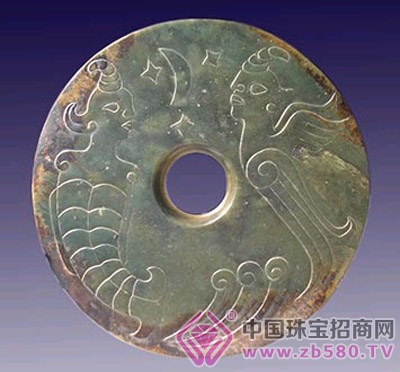According to archaeological findings, the jade was first produced in the Neolithic Age about five or six thousand years ago. Many sites and tombs of Liangzhu Culture in the lower reaches of the Yangtze River were unearthed. Due to the limitation of the cutting tools, the jade in this period is not well-formed, and some have traces of cutting, and the surface photon has no grain. The edges of Hongshan jade meat are thin-bladed, and the outer edge of Liangzhuyu is thin and the inner edge is thick. Due to the age of the ancient jade, the carcass has traces of different colors such as ochre, rust and gray. In the Ming Dynasty, there were a large number of jade, complex types, and incomplete processing. The jade was mostly sapphire, white jade, and a small amount of jasper. Most of the bodies are relatively small, with common embossed crepe lines, as well as those with grain and moiré. The nipples are round and large, slightly flat, and there are often traces of tubular drills around them. In the Ming Dynasty, the jade was mainly used for wearing. Li Jiufang, a jade expert, believes that in the Ming Dynasty, the large-scale engraved grain, silk, ply and dragon, phoenix, and animal face jade in history rarely appeared. In the Ming Dynasty, the rounded corners of the crepe and the embossed lines on the jade are square and the inner circle is hard and straight. The workmanship is generally sloppy, rough, and there is a so-called "rope" at the corner of the inscribed line. In the Qing Dynasty, the jade was dominated by Xinjiang white jade and sapphire, as well as jasper and ink jade. In the Qing Dynasty, the jade was much smaller, the body was thicker, the perforation was smaller, and the double cymbal with the ring sleeve appeared in the middle. The geometric patterns, auspicious patterns and character patterns appear on the jade ornaments, and the realism is strong. The antique jade in the Qianlong period of the Qing Dynasty was realistic and beautiful. Zhang Guangwen, a researcher at the Palace Museum and a jade expert, believes that the vast amount of jade plaques made by the Qing dynasty is based on the works of the Han Dynasty, mainly the glutinous rice, the pupa and the deformed animal face. Gu Yu and Pu Pu, in the shape and craftsmanship, strive to pursue the characteristics of the Han Dynasty, but do not add to the old treatment. There are many types of this kind of jade, especially two kinds, one is Yihan style; the other is directly carving the Chinese animal face or four spirits on the inside. In the late Qing Dynasty, the quality of the jade was poor, the work was rough, and only the shape was similar. Yuxi, especially in the Warring States Period, the Han Dynasty, and the Ming and Qing Dynasties, were much loved by people. Nowadays, the fake ancient jade scorpion floods the antique market and has to attract the attention of collectors. The author has also bought antique jade for many times and suffered greatly. The industry believes that the collection of ancient jade, must master the style characteristics of ancient jade in different eras. A piece of ancient jade, the first thing to look at its overall shape, followed by its craftsmanship, and again look at the jade color. The pseudo-made jade, the overall image is often disorderly, the proportion is out of balance, the body is cautious, the stagnation is rigid, the lines are not smooth, and the vitality is lacking. Process technology is often sturdy, portrayed with distortion, or deliberately realistic, but tangible. In terms of jade color, jade color is not pure, mostly jade, gray and dry. The twilight floats on the surface, not the transition color, or the color is too new, too bright, or the position is too clever, the rule is too regular, the level is single, the rigid stereotype. In short, only by looking at the real thing and looking at the map, can we accurately distinguish between true and false jade and accurately grasp the style characteristics of jade in different eras. The use of jade is based on ancient records and speculations by the descendants. One is a sacrificial device, used for offering sacrifices, offering sacrifices to the mountains, offering sacrifices to the sea, offering sacrifices to the river, and offering sacrifices to the stars. The second is the ritual device, used as a symbol of ceremonial or as an identity ("Zhou Lichun Guan Zongbo Dian Rui" cloud: "Zi Zhiyi, male puppies" and so on. The third is the decoration. The balance used by the four weights. Five for evil spirits and antiseptic. These uses of the jade are almost all in the Spring and Autumn Period and the Warring States Period, and evidence can be found in ancient literature and modern archaeological excavations. Yuxi is a grand ritual instrument in ancient China. Zhou Li: "Take the sky with the sky." At that time, Lin Huiyin designed the national emblem pattern to take the jade as the main body. Yuxi is a kind of jade that is relatively core in ancient Chinese jade culture. Its history has lasted for more than 5,000 years. In the traditional Chinese cultural concept, Yuxi symbolizes good wishes and noble qualities. At that time, Lin Huiyin designed the national emblem pattern to take the jade as the main body. Women'S Fitness Yoga Wear,Women'S Seamless Yoga Wear,Women'S Yoga Wear,High Stretchy Yoga Wear Shaoxing Yizhong Textile And Garment Co.,Ltd , https://www.yizhongsport.com

November 04, 2022